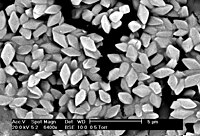
Photo from wikipedia
The local entomopathogenic bacterium, Bacillus thuringiensis (Bt) was isolated and characterized from 16 soil samples collected from different governorates in Egypt. Among 56 bacterial colonies obtained, only 16 colonies were… Click to show full abstract
The local entomopathogenic bacterium, Bacillus thuringiensis (Bt) was isolated and characterized from 16 soil samples collected from different governorates in Egypt. Among 56 bacterial colonies obtained, only 16 colonies were characterized by traits of Bacillus. All the 16 isolates were toxic to the neonates of the cotton leaf worm, Spodoptera littoralis (Boisd.) (Lepidoptera: Noctuidae). Damietta and El-Sharkyia bacterial isolates showed appreciable mortality rates (100 and 96.6%), respectively, which were higher than that caused by the standard isolates of Bt entomocidus (that produce Cry1 C toxin) for which they were selected for further characterization. Scanning electron microscope of Damietta bacterial isolate showed the presence of a bipyramidal crystal protein; consistent with the presence of Cry1 toxin class, however, El-Sharkyia bacterial isolate produced spherical-shaped crystals consistent of Cry2 toxin class. Electrophoretic patterns of different isolates and standards revealed different molecular weight bands, ranged from 195 to 8KDa. Damietta and El-Sharkyia bacterial isolates produced major protein bands with molecular weights of 130 KDa, which was also present in Bt entomocidus. Both isolates also shared protein bands with Bt entomocidus with molecular weights of 80, 70, 65, 51, and 22 KDa. The 16S rRNA sequences of both isolates were submitted to the NCBI Gene Bank database, with accession numbers of LC070660 for Damietta isolate and LC070661 for El-Sharkiya isolate. The existence of different Cry genes in the 2 isolates was studied by PCR, using general primers of 5 Cry genes. Cry1 gene was detected in both isolates; however, Cry 2 gene was detected only in Damietta isolate.
Journal Title: Egyptian Journal of Biological Pest Control
Year Published: 2020
Link to full text (if available)
Share on Social Media: Sign Up to like & get
recommendations!